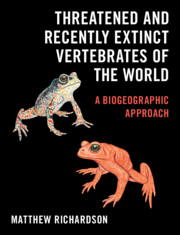Book contents
- Threatened and Recently Extinct Vertebrates of the World
- Threatened and Recently Extinct Vertebrates of the World
- Copyright page
- Dedication
- Contents
- Foreword
- Preface
- Acknowledgements
- Chapter 1 The Arctic Realm
- Chapter 2 The Palearctic Realm
- Chapter 3 The Afrotropical Realm
- Chapter 4 The Madagascan Realm
- Chapter 5 The Indo-Malaysian Realm
- Chapter 6 The Papua-Melanesian Realm
- Chapter 7 The Australian Realm
- Chapter 8 The Polynesian Realm
- Chapter 9 The Nearctic Realm
- Chapter 10 The Caribbean Realm
- Chapter 11 The Neotropical Realm
- Chapter 12 The Patagonian Realm
- Chapter 13 The Antarctic Realm
- Chapter 14 The Oceanic Realm
- Chapter 15 Global Balance
- Bibliography
- Index
Chapter 10 - The Caribbean Realm
Published online by Cambridge University Press: 24 February 2023
- Threatened and Recently Extinct Vertebrates of the World
- Threatened and Recently Extinct Vertebrates of the World
- Copyright page
- Dedication
- Contents
- Foreword
- Preface
- Acknowledgements
- Chapter 1 The Arctic Realm
- Chapter 2 The Palearctic Realm
- Chapter 3 The Afrotropical Realm
- Chapter 4 The Madagascan Realm
- Chapter 5 The Indo-Malaysian Realm
- Chapter 6 The Papua-Melanesian Realm
- Chapter 7 The Australian Realm
- Chapter 8 The Polynesian Realm
- Chapter 9 The Nearctic Realm
- Chapter 10 The Caribbean Realm
- Chapter 11 The Neotropical Realm
- Chapter 12 The Patagonian Realm
- Chapter 13 The Antarctic Realm
- Chapter 14 The Oceanic Realm
- Chapter 15 Global Balance
- Bibliography
- Index
Summary
The Caribbean Zoogeographic Realm, as here defined, consists of the Lucayan Archipelago and the more than 7000 islands, islets, reefs, and cays of the Greater and Lesser Antilles. In the past it has been variously considered as part of either the Nearctic or Neotropical realms, and is in many ways a transition zone between the two. On the basis of its many endemic species, however, it is here treated separately. The islands within this realm, more properly known as the West Indies, are a geographically complex system stretching over 3000 km from the Florida peninsula to the northern coast of Venezuela. They consist of active volcanoes, low-lying coral atolls, raised limestone plateaus, and large fragments of continental crust containing tall mountains and insular rivers. Each of the three main archipelagos has a unique origin and geological composition. The Lucayan Archipelago, which includes the Bahamas and the Turks and Caicos Islands, is a chain of barrier reefs and low islands atop the Bahama Platform of the North American Plate. Its emergent islands likely formed from accumulated deposits of wind-blown sediments during Pleistocene glacial periods of lower sea levels. The Greater Antilles are geologically the oldest, and include both the largest islands (Cuba, Hispaniola, Jamaica, and Puerto Rico) and the tallest mountains in the Caribbean. Composed of strata of different ages as well as island arc deposits and oceanic crust, they originated near the Isthmian region of present-day Central America and drifted eastwards before finally arriving at their current location after colliding with the Bahama Platform around 56 million years ago. The islands have been continuously exposed since, although which areas were above sea level during this history remains unresolved. The Lesser Antilles, by contrast, are a volcanic island arc extending along the leading edge of the Caribbean Plate. Its major islands likely emerged less than 20 million years ago. Most of the West Indies were originally covered by tropical forests and scrub, and had one of Earth’s most impressive biodiversities. Many Amerindian cultures were historically indigenous to it as well, with evidence dating some of them back to the mid-sixth century b.c. The first to arrive there are thought to have originated in northern South America from where they gradually swept north, wiping out many remarkable species in the process including giant owls and dwarf ground sloths. What remains is but a pale shadow.
- Type
- Chapter
- Information
- Threatened and Recently Extinct Vertebrates of the WorldA Biogeographic Approach, pp. 412 - 434Publisher: Cambridge University PressPrint publication year: 2023

